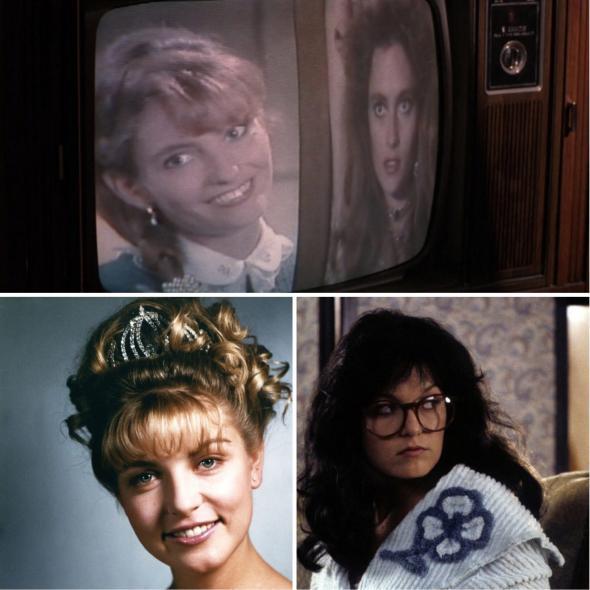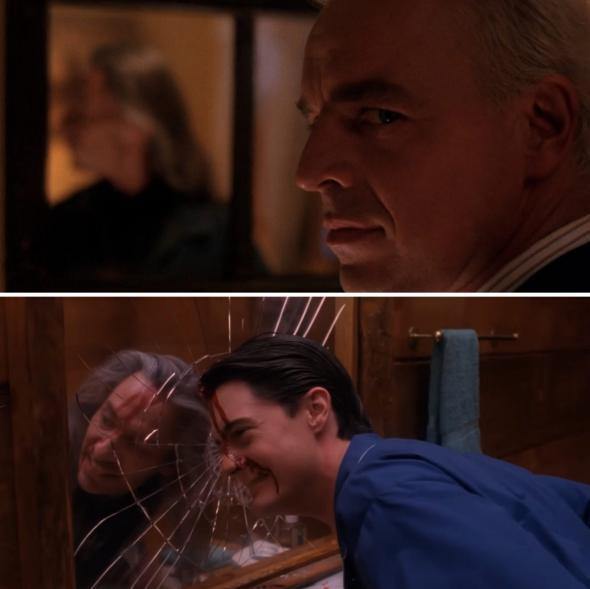Since Twin Peaks premiered more than two decades ago, barrels of ink have been spilled over how Twin Peaks influenced TV. Fewer writers, meanwhile, have done as the Man From Another Place would do, and flipped that question around backward: How did TV influence Twin Peaks?
This is no less important, because Twin Peaks’ distinct power was inextricable from its context on 20th-century American network TV, something it was in direct dialogue with. And now that it’s coming back 25 years later, to an almost unrecognizable TV landscape—and on a premium cable network, no less—that could present a problem, because as you might have heard, TV has changed a lot.
It shouldn’t be surprising that Twin Peaks was, in part, a twisted pastiche of network TV. After co-creators David Lynch and Mark Frost pilfered from across the dial (not to mention from film and from real life), they never tried to cover their tracks. Instead, they confessed to their thefts openly. “I call the show a cultural compost heap,” Frost told People. “There are symbols and characters and expressions from all the shows we saw growing up that echo and ping down the hallways of Twin Peaks.” And many of their references were extraordinarily unsubtle: When they wanted to borrow from the 1960s drama series The Fugitive, for example, they not only gave the show a one-armed suspect nicknamed the One-Armed Man, just like the suspect from that show, they gave him the full name Philip Gerard, after The Fugitive’s own Lt. Philip Gerard.
But this is what happens when a piece of pop cultural bricolage becomes more famous than the sources it samples: Viewers no longer see its borrowing, no matter how blatant it is. Instead, what becomes more obvious is how its artistic descendants have stolen from it. When AMC released The Killing in 2011, advertising it with the slogan, “Who killed Rosie Larsen?”, it struck most ears as, as Slate’s own TV critic put it, “an unapologetic echo of the question motivating Twin Peaks.” Fewer heard it as an echo of Dallas’ own ad slogan “Who shot J.R.?”, the question that Twin Peaks itself was echoing.
That Twin Peaks is interested in commenting on TV is perhaps most apparent in its frequent depiction of TV, in the form of the show-within-a-show Invitation to Love. The fictional daytime soap opera, which is beloved by the residents of the titular Pacific Northwest town, appears in six of Twin Peaks’ first eight episodes. When Frost explained his and Lynch’s motive for spending so much airtime on this fictional television show, he said, “I think that watching television is a big part of people’s lives in this country and you very rarely see that treated in television.”
Card-carrying members of the cult of Twin Peaks may be tempted to view Invitation to Love as simply a spoof of daytime soap operas, the sort of show at which they, the connoisseurs of David Lynch’s oeuvre, would turn up their noses. And it’s no coincidence that Invitation to Love’s opening title sequence (during which a narrator intones, “Every hour holds the promise of an Invitation to Love”) closely mirrors that of the never-ending soap Days of Our Lives (which begins with the tagline “Like sands through the hourglass, so are the … Days of Our Lives”).
But as Twin Peaks continues, it deliberately frustrates this reading. Take Twin Peaks’ soapy doppelgänger plotline. When Twin Peaks first introduces Maddy Ferguson, the brunette doppelgänger of Laura Palmer, some viewers might flatter themselves by recognizing this as an homage to Alfred Hitchcock’s Vertigo. And of course, it is: Maddy Ferguson even gets her first name from Vertigo’s blond-to-brunette doppelgänger Madeleine, while her last name comes from Madeleine’s lover, Jimmy Stewart’s Scottie Ferguson. But Invitation to Love pointedly reminds us that doppelgängers are not just a feature of Hitchcock’s work; they’re also a regular feature of soap operas, where they just call them evil twins. Around the same time Maddy appears on Twin Peaks, Invitation to Love is shown introducing its own evil-twin plot, with the characters of Emerald and Jade, played, just like Laura and Maddy, by the same actress.

Top: Twin Peaks/Netflix. Bottom: ABC Photo Archives/American Broadcasting Companies, Inc.
In this way, Twin Peaks makes clear that it’s not spoofing soap operas. Instead, it’s more like a mirror reflection of them, what the show calls a “shadow-self.” The show is full of these twins and “double lives”—from Maddy and Laura to Emerald and Jade to the Black Lodge and the White Lodge to the mirrored figures in the original run’s final shot, not to mention the name Twin Peaks itself—and it uses them to do what mirrors often do in the show: reveal a dark secret underneath.

Twin Peaks/ Netflix
The soap that perhaps influenced Twin Peaks most was Peyton Place, a 1960s series about the inhabitants of another small mill town. When Frost and Lynch first got the idea for Twin Peaks, they rented a Beverly Hills screening room and screened the original 1957 Peyton Place film that preceded the series. Later, they even cast Russ Tamblyn, who starred in that movie, as Twin Peaks’ Dr. Lawrence Jacoby. (In fact, anyone who picked up on the parallels between Peyton Place and Twin Peaks, as many critics did, could have foreseen the answer to who killed Laura Palmer: The secret at the center of both Twin Peaks and Peyton Place is that a young girl is being serially raped by her father or, in Peyton Place, her stepfather.)
And in case you didn’t pick up on Twin Peaks’ echo of Dallas in its ad slogan, Twin Peaks appropriated from the “Who shot J.R.?” plotline even more shamelessly for its Season 1 finale. In a carbon copy of that soap’s famous season-ending cliffhanger, Twin Peaks ended its first season by shooting a beloved main character (in Twin Peaks’ case, it’s Agent Cooper) and leaving the viewer to guess the culprit.
About their debt to soaps, too, Frost and Lynch were characteristically upfront. When the Guardian asked Lynch in 2014 whether Twin Peaks was a soap parody, he said, “No, no, no, no, no. It is a soap opera.” But Twin Peaks didn’t lift only from soap operas. It copied just as openly from other TV genres—especially police procedurals. Frost’s primary gig before Twin Peaks was, as is often noted, as a writer and story editor on Hill Street Blues. Less often noted is that Michael Ontkean, Twin Peaks’ Sheriff Harry S. Truman, was perhaps best known previously for his starring role as Officer Willie Gillis in the 1970s procedural The Rookies. Even Norma Jennings, the owner of Twin Peaks’ Double R Diner, is played by Peggy Lipton, who was best known for her award-winning starring role as one of the undercover cops on The Mod Squad. And the duality motif comes into play here, too. The Fugitive-inspired Philip Gerard, it turns out, is one half of another double: He is possessed by Mike, the good spirit who hunts Twin Peaks’ own Big Bad, the evil spirit Bob.
Lynch’s interest in exploring television as not just a medium but as a subject didn’t begin or end with Twin Peaks. One of his earliest shorts was 1967’s “Fictitious Anacin Commercial,” which did for medicine advertisements what Twin Peaks did for soaps and procedurals: take something that appears wholesome and mundane and pervert it into something surreal that hints at more disturbing realities. The 60-second spot at first resembles a run-of-the-mill commercial for a headache or allergy medicine, but the subject’s suffering quickly worsens, and jump cuts suggest it could involve hallucinations, violent psychotic episodes, or intermittent bouts of possession by Bob. After a dose of Anacin, the man runs manic through the fields, dancing and stripping off his clothes. Perhaps he’s singing “Mairzy Doats.”
And right after Twin Peaks made Lynch a household name, he and Frost launched the little-remembered series On the Air, about the behind-the-scenes workings of a fictional 1950s television series. It was the one kind of scripted TV that Twin Peaks emphatically wasn’t—a sitcom—and ironically On the Air wasn’t on it for very long. In what came as a surprise to ABC executives, if not to most fans who’d followed Lynch’s work, it was more creepy and baffling than it was funny, with supernatural elements and a director whose accent, moustache, and mannerisms resembled Hitler’s.
Lynch returned to the sitcom format again with the 2002 web series Rabbits, and this time no one could mistake him as intending to make a conventional comedy. The one-set “sitcom,” which follows a set of humanoid bunnies, features droning Angelo Badalamenti music, frequent interruptions from a demonic presence, and a laugh track that only bursts into laughter at the most inappropriate moments, such as in the middle of long, uneventful silences. It is deeply unsettling.
Though audiences tend to fixate on what made Twin Peaks strange, it’s the more familiar stuff that made it Lynchian. The central conceit of the show was to take all the appearances of network TV comfort food—the American-as-cherry-pie set dressing of family sitcoms, the conscientious-law-enforcement-officer-steadily-solving-a-mystery structure of police procedurals, the airbrushed and star-crossed love triangles of daytime soap operas—and to suggest that they conceal a host of much more unsettling horrors in American life, if you’ll only get up and look in the mirror. People think of the demon spirits and the backward-talking little person as the features of the show that were most quintessentially Lynch, but the everyday banalities of coffee and diners and drape runners were just as crucial. As David Foster Wallace famously put it in his own definition of the term Lynchian, the term refers to an ironic combination of “the very macabre and the very mundane” that “reveal[s] the former’s perpetual containment within the latter.”
This tension is what made it so shocking that Twin Peaks aired on network TV in the 1990s. Its relationship with the formula of network television was central to its creepiness. And this is also one reason why the Twin Peaks movie, Fire Walk With Me, was received so coldly. Premiering at Cannes, where it was freed from both the context and the strictures of network TV, it veered too far away from the mundane and into the macabre. No wonder it was booed. At Cannes, arty, surrealist nightmares are a dime a dozen.
Now, in the post-Peaks world of Peak TV, arty, surrealist nightmares have become commonplace on TV, too. One need only look to the shows that Peaks has inspired, such as Wayward Pines, Legion, Mr. Robot, True Detective, and Riverdale. This could make Lynch and Frost’s job in rebooting the show—the new season airs on Showtime—more tricky. In the decades since Peaks aired, prestige TV has become a genre-size subversion of network television’s tropes—a rejoinder to its predictable plots and neat emotional arcs and implicit promise to comfort rather than to challenge and unsettle. So how can Peaks tap the mundanity of TV now that it’s helped make TV less mundane and more macabre?